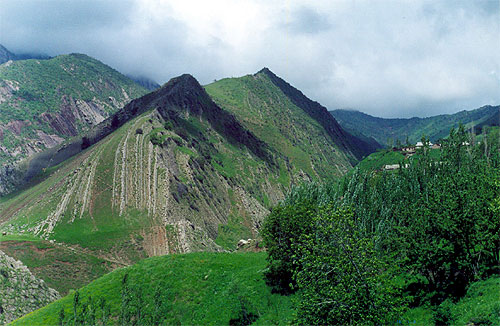Roman legionaries in Central Asia? August 18, 2010
Author: Beach Combing | in : Ancient , trackback
Beachcombing has written before about Roman penetration into central Asia and even possible direct contacts between Rome and the Chinese Imperial court. Tonight he wants, instead, to look at a claim that Romans – it is argued legionaries – visited western Uzbekistan close to Afghanistan in the early centuries AD.
First, it should be stated that this would be an extraordinary occurrence. But it is not an insane or impossible suggestion. It is certainly not, say, like claiming that Mongol elephants raced through the New World or that the ancient Celts reached New Zealand.
After all, Alexander conquered into Afghanistan and India. Armenia was briefly a Roman province in the second century AD and a Roman ‘protectorate’ for much, much longer. And Beachcombing himself has enjoyed setting out the evidence that a Roman military detachment went just a little further and left an inscription on the western banks of the Caspian Sea.
But Uzbekistan…
Uzbekistan is, well, central-central Asia. It is beyond the Caspian and then some: far into what are among the wildest lands on earth. It is easy to imagine Roman merchants being brought here by the Silk Road. But a Roman military detachment in these parts sends tremors through the central nervous system.
In any case, onto the evidence.
In the late 1980s ‘Mediterranean’ graffiti was discovered in a complex of caves at Kara-Kamar in Uzbekistan near the border with Turkmenistan and Afghanistan, to the west of Termez.
Beachcombing has rather ungenerously put the word ‘Mediterranean’ in inverted commas because there is no firm Roman or Greek hand here, just a fascinating hypothesis.
The three inscriptions (the first two in Latin, the third in Greek) are extremely abbreviated. This is natural in Roman inscriptions and even more so in graffiti. But it also means that a few scratches, possibly from another alphabet or epoch could easily be misread into Latin or Greek, especially given that there are other graffiti in Russian, Uzbek and Arabic that complicate the readings.
So the letters ‘I M‘ at the end of the first inscription (see end of post) are taken by their editor to be an abbreviation for ‘Invictus Mithras’, ‘Unconquered Mithras’. The editor goes on to suggest that the complex may have been used by Roman soldiers as a Mithraeum, which is certainly daring! Beachcombing wonders if it would have been quite, well, ‘polite’ for a devotee to abbreviate a god’s name – i.e. Mithras – in this fashion.
AP LG is meanwhile interpreted as ‘AP(ollinaris) L(e)G(io)’ ‘the Apollonian Legion XV’. The XV was based in Cappadocia in the east of the Empire so this would make sense, but again the ‘abbreviation’ (if that is what it is) could be read in other ways and the missing number is curious.
Is there any evidence that gives some context to these finds? The Historia Augusta, a frighteningly unreliable late Roman ‘history’ (lots of inverted commas today…), claims that the Emperor Hadrian (117-138) received ambassadors from the Bactarian kings, almost certainly the Kushan Emperor, offering friendship and the Kushan Empire would have controlled Kara-Kamar. Military contact could have come on the back of such a visit or another now forgotten embassy. Alternatively the Roman soldiers could have been prisoners.
The publication of this fascinating series came under Yulia Ustinova a wanw thoroughbred classicist who has written on werewolves and Greek caving. Her authority means that these inscriptions must be taken seriously. But they are not – and Beachcombing is biting his inner cheek with frustration as he writes this – certain evidence that legionaries came to the very borders of Afghanistan in the early empire.
More’s the shame.
Any other views on these inscriptions or, indeed, any other Roman evidence from Central Asia would be gratefully received: drbeachcombing AT yahoo DOT com
Yulia Ustinova, ‘New Latin and Greek Rock–Inscriptions from Uzbekistan’, Hephaistos 18, 169-179
1) ROD/ PAN …/ I M
2) PAN/ G REX/ AP. LG
3) RIPOS ETHE(KE)
***
1st Sep 2010: Yulia Ustinova at Ben Gurion university very kindly responded to Beachcombing’s description of her findings at Kara-Kalamar with the following email (quoted in part). ‘In fact, I still think the inscriptions were left there by Roman soldiers, probably captives: there were no other inscriptions in Latin or Greek characters in the cave, and while those in Latin consist of abbreviations that – theoretically – can be interpreted otherwise, the Greek one is unequivocal. Now, who and when could leave a Greek inscription in Uzbekistan? I still consider the suggestion put forward in the Hephaistos article plausible.’ Beachcombing got so excited about the Latin inscriptions that he rather raced over the question of the Greek inscription. The professor’s point is surely a vital one then. Beachcombing thanks Professor Ustinova for her very great kindness!



